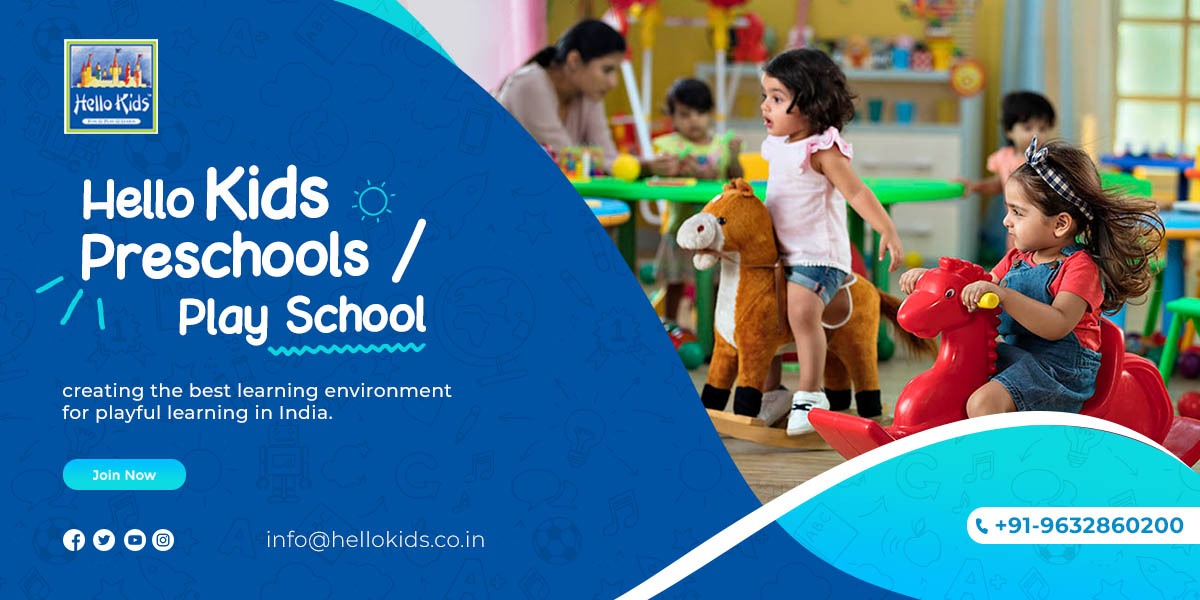
Hello Kids Preschools creating the best learning environment for playful learning in India
Early childhood education describes the period of learning that takes place from birth to 8 years old. Safe, responsive, and nurturing environments are an important part of supporting the learning and development of infants, toddlers, and preschoolers.
We don’t need to teach a child, we need to create learning environment, Pritam Agrawal, Founder and Director, Hello Kids Chain of Preschools / Play Schools.
It is a time of remarkable growth and important milestones in brain development. During this stage, children are highly influenced by the environment and the people that surround them. ( UNESCO 2020 )
In early years, children are mostly influenced by the environment and the people around them.
That being said, it is good to assess how the whole learning environment is set up to support children’s playful learning such as:
- Lesson plans and activities
- Learning materials such as toys, building blocks, painting and writing materials, etc.
- Observations, documentation, and formative assessment of learning
- The activity areas
- Educator’s pedagogical skills and competencies when working with the children
- Curriculum and learning objectives for playful learning
- Action plans, syllabus, weekly and daily plans
- All these should encourage & support the children to play, interact, and practice cognitive processes such as problem-solving and controlling feelings. Play motivates children, brings joy, and supports the children’s well-being. It allows them to learn new skills whilst enjoying the learning.
Our regular activities areas in the learning environment
- Block time : Wooden toys & blocks, kids arrange by size and shape. Blocks help children learn to take turns and share materials, develop new friendships, become self-reliant, increase attention span, cooperate with others, and develop self-esteem. – Sunita Jain CEO, Hello Kids Chain of Preschools. Helps the child’s development in all areas including fine and gross motor skills.
- Math/Manipulative time : Math is important and it’s important to help young children develop their mathematical thinking. A child’s math knowledge at the start of kindergarten predicts later academic achievement better than early reading or attention skills. Math is part of children’s everyday lives. We offers a variety of materials including puzzles, small blocks, Legos, games, tiles, geoboards, attribute blocks, and other hands-on materials that foster children’s thinking and problem-solving skills and support the development of math (counting, operations, numbers, measurement, geometry).
- Library / Reading time : with a variety of books to create a reading habits as reading in early years develops & promotes brain development and imagination, develops language and emotions, and strengthens relationships. Sometimes you can read. And sometimes you can look at picture books, sing songs or tell stories from your culture.
- Writing time : A writing/drawing area that provides different types of paper, crayons/markers/pencils, and maybe stamps, stencils, alphabet charts… These materials can be combined with art materials (for younger children) or separated into their own area when children become more advanced in the literacy development.
- Art time : we offers different types of paper and drawing materials (crayons, markers, etc.), as well as paste or glue, scissors, stamps, watercolors, pastels, and tempera paints and brushes, an easel or table available for a large painting, collage and construction materials, and other assorted materials such as playdough and clay. Artistic activities foster intellectual development and some of their benefits are: Stimulates both sides of the brain. Increases the capacity of memory, attention and concentration. Helps develop reading skills and children do better in math and science. Introduces children to new vocabulary and concepts.
- Science time : A science area that includes magnifying glass(es), sand/water table, possibly animals (guinea pigs, snails, mealworms), and other natural items (eg. plants, rocks, shells, leaves…) depending on the time of the year, current topic, or interests of the children in the classroom. Within this area, children should be given time to experiment with measuring, counting, pouring, and making predictions.
- Role / Dramatic play time : A dramatic play area for younger children that can be used as a “house” or any other setup that is interesting for the children or the essence of the current topic (eg. post office, train station, grocery store…).
- Socialising / Meeting Area : A large meeting area for the whole group of children gathering together for circle time, group discussions, storytime, and music/movement activities. It can be in one of the areas of the classroom, such as the block area or the library, that has enough floor space.
- Play / Outdoor Area : An outdoor play area is ideal as children love to run around, jump, climb and play freely in the natural environment – why not grow your own vegetables even? Everyone surely feels refreshed after spending some time outdoors. If possible, it is easiest if the outdoor space is connected directly to the classroom.
See Also: 8 Points to Consider While Buying or Selecting a Play School, Preschool Franchise in India
Follow the author Pritam Kumar Agrawal on https://www.facebook.com/PritamAgrawalPage
Contact Pritam Kumar Agrawal by WhatsApp +91 9880457004, founder@hellokids.co.in
Enquire us for Hello Kids Preschool Franchise


